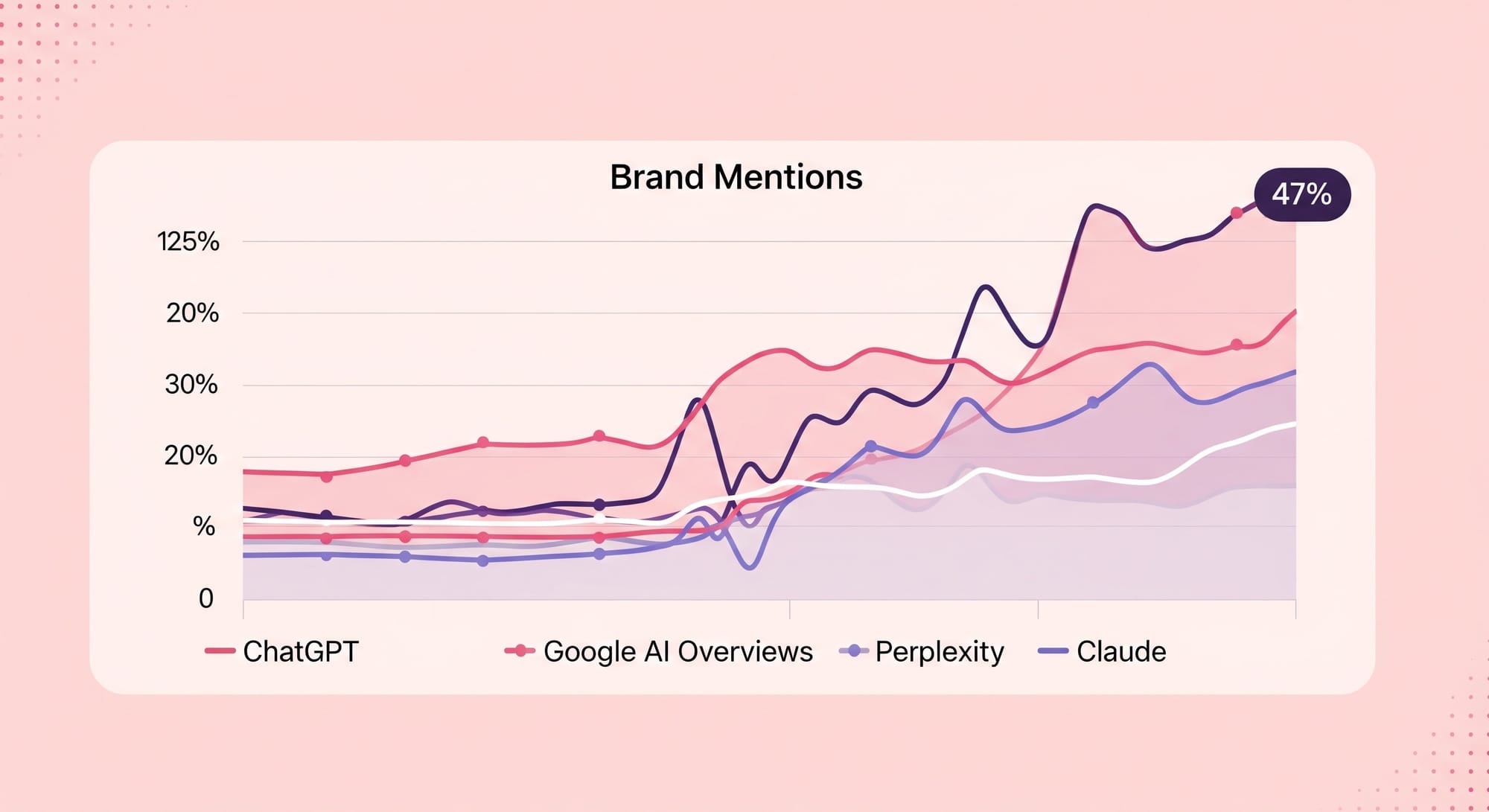What Is AI Visibility? A Simple Explanation—Everything You Need to Know

Author: Norway Hamzah, AI Researcher Engineer at LAB3
Last Updated: July 23, 2025
Keywords: Explain AI visibility, Friendly explaination, Generative Engine Optimization, GEO vs SEO, Answer Engine Optimization, LLM-friendly content structure, How to improve my brand’s AI visibility in ChatGPT, What is the difference between GEO and SEO
1. What Does “AI Visibility” Actually Mean?
Let me tell you about a moment that changed how I thought about content.
A few weeks ago, I opened ChatGPT and typed:
“What’s the best lightweight CMS for startups in 2025?”
I expected to see my product somewhere in the answer. It wasn’t. Not even close. Despite spending months optimizing our site for SEO—clean URLs, solid keyword clusters, fast load speeds—the AI didn’t know we existed.
That’s when the tearm: AI visibility appeared in my mind. AI visibility isn’t the same as SEO visibility. It’s not about being ranked. It’s about being remembered. Specifically, it means your brand is quoted, mentioned, or recommended in responses generated by large language models like ChatGPT, Gemini, Perplexity, or even Google’s AI Overviews.
To earn those mentions, your content must be structured in a way AI can actually use—FAQ formats, direct answer summaries, schema markup. You’re not optimizing for crawl bots anymore. You’re curating for AI memory.
2. AI Visibility Matters—And the Big Players Know It
AI visibility isn’t a niche experiment—it’s now already mainstream strategy. Major brands across industries are fully embracing it, and here’s how we know the shift is real:
- Rapid rise in AI Overviews
AI-generated answer boxes now appear in 13.14% of Google searches—up from 6.49% in just two months (January to March 2025) (Semrush, MarTech). - Quality traffic that converts
Visitors coming via AI answers convert 4.4× better than standard organic search users (Search Engine Land, Semrush). - No major drop in clicks
Zero-click results dropped only slightly (38.1% → 36.2%) after AI Overviews launched (Semrush). - Tipping point forecasted
Semrush projects that LLM-driven channels will rival or exceed traditional SEO traffic by 2027–2028 (Just Global | B2B Marketing Agency, Vogue Business).
Brands Making AI Visibility a Top Priority
AND this isn’t just theory—it’s active transformation:
- Wix just launched its AI Visibility Overview—a dashboard that tracks how often your brand is cited and with what sentiment across AI platforms (TechRadar).
- LVMH (luxury goods) partnered with Google Cloud to integrate AI into their supply chain, marketing, and brand messaging—ensuring their names are recognized and cited across AI channels (Wall Street Journal).
- Victoria’s Secret, Swarovski, and Saks Global have embedded generative AI into customer personalization and search functions, effectively shaping AI visibility through intent-based product discovery (Vogue Business).
- H&M is using AI for store operations and personalization—realigning its digital presence to emerge in voice- and AI-driven shopping assistants (Wall Street Journal).
- General Motors is adopting AI in marketing, manufacturing, and pricing—an indication that even automotive brands are optimizing for AI discoverability, not just internal efficiency (Business Insider).
- Retailers overall saw AI-driven traffic surge by 1,200% from July 2024 to Feb 2025, and during Amazon Prime Day, it spiked 3,300% year over year—signaling huge shifts in how shoppers discover products via AI-driven tools (Retail Brew).

3. Why Are AI Bots Still Ignoring My Brand?
Now back to that CMS test that failed at first. I started testing our brand name across multiple prompts and models—ChatGPT, Gemini, Perplexity. The result was always the same: silence.
This was surprising because I’d done everything by the SEO playbook. We had backlinks, domain authority, great internal linking. So why were we invisible to AI?
Here’s what I discovered: Google and LLMs behave like two totally different interviewers.
- Google wants your résumé—backlinks, keywords, rank signals.
- LLMs want your story—clear, useful, structured knowledge they can quote in seconds.
According to Semrush, Google’s AI Overviews appeared in 6.49% of searches in January 2025—and by March, that number had soared to 13.14%. But here’s the twist: many of the URLs cited weren’t from page one. In fact, studies from PPC Land and Reddit user analysis show that AI often pulls content from page two or three—as long as it’s structured well enough to be chunked and quoted.
So what does “chunk-quality” look like?
- Clear, scannable H2s that answer one question at a time
- Summary-first paragraphs that begin with the takeaway
- Schema markup like FAQ or HowTo that gives AI explicit cues
Once I restructured an old article this way, it began showing up in AI-generated responses—even though it still sat at #12 on Google. That told me something big: domain authority matters less to AI than answer authority.

Analogy time: SEO is like you shouting through a megaphone in a stadium. AI visibility, though? That’s like whispering your secret sauce to a Michelin-star chef. It’s subtle. But when it works, you’re part of the final recipe.
4. How to Measure AI Citations
Next question is "How do you know if your content is AI-Ready?" You’ve moved beyond SEO—your content is structured and chunk-friendly. But how do you prove it’s catching AI’s attention? Here’s my lab-tested, two-pronged method that transforms guesswork into data you can act on 👇
Step 1: DIY Prompt Check
Think of this as a quick AI check-up. I open ChatGPT, Gemini, or Perplexity and ask something like:
“What are the best email‑marketing tools for B2B companies?”
Then I watch. Does my brand get named? Is it praised early—or buried deep? Detailed results—or no result at all—tell me how visible my brand really is. I repeat this under different prompts and models to build a snapshot. This hands-on test reveals how AI currently understands (or misunderstands) my content.
Step 2: Track with AI Visibility Tools
You can level up from manual checks to systematic monitoring. Tools like Semrush AI Toolkit and Wix AI Visibility Overview offer full-stack insights into your AI visibility performance. These platforms:
- Track how often your brand gets cited or mentioned across ChatGPT, Gemini, Perplexity, AI Overviews, and more (Semrush, Semrush, Semrush)
- Check share of voice: compare how often AI names your brand versus competitors (Avenue Z)
- Analyze sentiment: is AI featuring your brand positively, neutrally, or… poorly? (Semrush)
- Surface opportunity prompts where competitors get mentions—you don’t (Semrush)
For example, with Wix, I saw my brand appear in AI answers for specific questions and learned how positive the AI sentiment was. It even showed which models mentioned me—ChatGPT vs. Perplexity vs. Gemini (TechRadar).
Why This Works — Faster, Smarter, Clearer
This approach turns guessing into measurable action:
- Know the where & why — Are you mentioned? Comparing to competitors? Feeling overlooked?
- Spot gaps instantly — Missing from important prompts? Negative sentiment creeping in?
- Iterate content quickly — Reframe headings, add supporting data or schema to plug holes.
Think of it this way: if you’re building SEO-influenced content but AI can’t “see” it, you’re invisible—this method flips that by giving AI a spotlight to shine on you.
5. Your AI Visibility Action Plan
In summary, here’s your friendly checklist:
- Prompt test today: Ask a key question related to your niche. Did your brand appear?
- Pick one article to optimize: Rewrite it with answer-first format, add schema, and embed 2–3 data points.
- Update headings: Re-craft them as questions (e.g. "What CRM features improve team efficiency?").
- Set monthly check-ins: Use Semrush or Wix to track citations and sentiment.
- Add human flair: Skip a paragraph now and then with taco or chef analogies to keep readers engaged.
TL;DR 📌
- AI visibility = being quoted, not just indexed.
- Structure, schema, data = what gets you quoted.
- AI traffic converts 4.4× better, and AI Overviews cover 13%+ of queries.
- The GEO wave is here—get ahead before your competition does.
Next Post Preview
In the next post, I’ll show you exactly how to transform a low-performing AI prompt into a win, applying specific optimizations and pulling brand mentions up from zero to hero. Want to see a real before/after?
